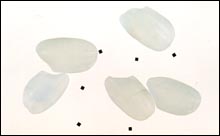NEW YORK - Japan's Hitachi has some big plans for a chip just slightly larger than a grain of sand.
The company says the tiny "meu-chip" can be embedded into paper in order to help authenticate a document, such as currency or business contracts. The chip itself is a 0.4-millimeter square with a thickness of only 60 microns (one micron is one millionth of a meter).
When connected to a tiny antenna, it can transmit a radio signal of about 30 centimeters. That's close enough for an external chip reader to determine if the paper that the chip is embedded into is authentic or not.
 |
|
| Hitachi's meu-chip compared to
individual grains of rice. |
|
|
|
|
Other companies like Gemplus (nasdaq: GEMP - news - people), the French company known for its smart card technology, already make a line of radio frequency ID (RFID) products. And late last year, chipmaker Motorola (nyse: MOT - news - people) teamed up with International Paper (nyse: IP - news - people) to push a system of electronic tags that could replace the bar codes found on nearly every consumer product on the market today.
Market research firm Frost and Sullivan estimates that the market for RFID tags, which can be used to track and identify goods and, among other things, protect against theft, is worth more than a $1 billion right now and growing rapidly.
One downside could be cost. Analyst Martin Reynolds of Gartner Dataquest wondered how the chip could be made cheaply enough to be economical for currency--especially larger bills. "Using this kind of technology can get expensive fairly quickly," he says. Hitachi didn't say how much the chips cost to make.
Hitachi, already one of the world's biggest chip companies--it reported more than $7 billion in semiconductor sales last year--plans to create a subsidiary company called Meu-Solutions to promote the uses of the chip.
The chip may be a little late to be included in U.S. currency, which has just been revised with new anti-counterfeit technology. Counterfeiters still try to copy American bills though: The U.S. Secret Service seized $252 million in counterfeit cash last year, most of which never made it into circulation.
Law enforcement agencies in Europe are worried about the changeover to a common currency in 12 European countries that is supposed to start on Jan. 1, 2002. The concern is that counterfeiters might exploit the confusion during the changeover period to pass fake euros, even though the notes have multiple security features including watermarks, security threads and foil holograms.
Hitachi will start selling samples in October to companies that want to use the chip in their own products, and will start producing higher volumes of the device by the end of the year.